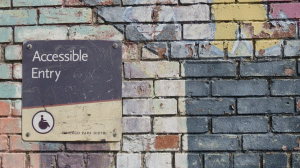Nowadays, terms like equal opportunity, appreciation and respect can be read on almost every career page. Just like sustainability, diversity is the new corporate buzzword. And it makes sense! Companies that present themselves as diverse appear more progressive and are preferred by most applicants. But often, much like greenwashing, the diversity is only superficial. In many instances, more diversity means more female, more international and more heterogeneous in age. One group is often left out of the equation - workers with disabilities. Most people see people of different skin colors and genders on a team and think of the team as diverse. The fact that people with disabilities exist and should be equally represented is regularly forgotten by the majority society - especially in the context of the labor market. So what does this mean for the invisible minority? In this article, Sophia Behrend investigates the current status quo for people with disabilities in the workplace.
Information in Simple Language:
Some groups have disadvantages in our society. They have worse opportunities than other groups. These groups are called disadvantaged groups. They include people with disabilities.
What are their chances on the labor market? In research, people with disabilities are rarely considered. However, what is not researched cannot be discussed as well. Disability should play a greater role in research. So that discrimination can be fought against.
In companies there is often a department for diversity. This department is called "diversity management." "Diversity“ refers to a variety of people with different backgrounds. "Management" means administration. So this department organizes and manages diversity. But what does diversity mean and when is diversity achieved? That is not properly defined. That's why diversity departments work very differently. How much people with disabilities benefit from diversity management is questionable.
Terms like equal opportunity, appreciation and respect can be read on almost every career page. Companies that present themselves as diverse appear more progressive and are preferred by most applicants. Science attests to numerous advantages of diverse teams under the right leadership: Increased productivity and creativity, greater resistance to crises and, last but not least, growing equality of opportunity (an overview can be found, for example, in the study "Diversity and the Success of Organizations" by economic sociologists and labor market researchers).
Disability is irrelevant
But diversity in companies is slowly evolving: the media reports racism, sexism and age discrimination in the workplace, declining quotas of women in DAX corporations, inequality of opportunity, assaultive behavior and bullying.
More diversity usually means more female, more international and more heterogeneous in age. One group is often left out of the equation: Workers with disabilities. Most people see people of different skin colors and genders on a team and think of the team as diverse. The fact that people with disabilities exist and should be equally represented is regularly forgotten by the majority society - especially in the context of the labor market.
The Diversity Barometer 2020, for example, a study by the business firm Warth & Klein Grant Thornton, Wedel University of Applied Sciences and Leuphana University Lüneburg, determines how diverse the executive boards of the 30 largest DAX companies currently are. Unsurprisingly, the study concludes that the average DAX board member is male, in his early/mid 50s and German. Not even worth mentioning, however, is that it's also not disabled. And that's a problem. If the dimension "disability" is not surveyed at all, it suggests that disability is irrelevant as a dimension of inequality.
Systematically excluded
Due to poorer educational opportunities and systematic barriers, people with disabilities rarely make it into the general labor market. The reasons for this are obvious and yet little is done. People with disabilities have demonstrably been systematically segregated from people without disabilities since the late 18th century. This practice dates back to a time when disability was valued as a deficit, a negative deviation from normality. This understanding still persists. Since the ratification of the UN Convention on the Rights of Persons with Disabilities (UN CRPD) in 2009, disability in Germany has been officially understood as an interaction that first arises between people with impairments and attitudinal and environmental barriers. Full, effective and equal participation in society must be enabled accordingly. Yet this is not happening.
The invisibility of people with disabilities is deeply entrenched. People with and without disabilities rarely meet. Many people with disabilities still learn in separate schools, work in a separate labor market and live in separate institutions. This separation has many disadvantages for them: Access to equal education is considerably more difficult. They are denied access to the general labor market. Social segregation is reinforced by exclusive living conditions. And the separation also has consequences for non-disabled people: Insecurity, fear of contact and prejudice against people with disabilities are the result. Most people do not even know how to correctly name people with disabilities.
There are no uniform diversity criteria
It is unclear when a company is truly diverse. There are no uniform criteria. As a result, different studies come to different conclusions. Infineon Technologies, Germany's largest semiconductor manufacturer, for example, currently ranks second in the Financial Times' Diversity Leaders ranking. The Diversity Barometer 2020, on the other hand, describes Infineon's gender diversity on the board as non-existent.
To date, there is no official representative data in Germany on the participation of people with disabilities in the primary labor market. What is known is that 320,000 people with disabilities are still employed on the second labor market in special facilities, i.e. workshops for disabled people. No one knows how many people with disabilities actually work according to their abilities and possibilities.
Barriers, lack of support, resignation
Of all people with disabilities of working age in Germany in 2017, only about 30% are integrated into the labor market. In an expertise of the Anti-Discrimination Agency from 2013, access to the general labor market was qualitatively examined. Only eighteen people with disabilities were interviewed comprehensively. The results are alarming: interviewees report ever new barriers, lack of support, discrimination and resignation in the face of catastrophic conditions. Despite these findings, the first large-scale study, commissioned by the Federal Ministry of Labor and Social Affairs, was not conducted until 2021. Eight years later.
Diversity managers as allies?
The growing importance of diversity management in companies gives hope for an active promotion of diversity and thus an improvement of the situation of people with disabilities and all other marginalized groups on the labor market. However, how companies actually shape diversity management, what goals are pursued and what strategies are applied varies widely. Examples include Commerzbank AG and then Deutsche Post DHL Group.
There are two focal points in diversity management: On the one hand, avoiding disadvantages for certain employee groups or discrimination against them. And on the other hand, recognizing and exploiting the potential of diversity in the workforce.
Sofia Strabis
Head of HR Diversity Management at Commerzbank AG
In close cooperation with the representative body for people with disabilities, many measures have been initiated at Commerzbank since 2016 that have made a decisive contribution to the treatment of employees and customers with disabilities. In 2018, it became the first bank in Germany to publish an action plan for inclusion based on the UN Convention on the Rights of Persons with Disabilities. Other measures included, for example, the establishment of accessibility as a necessity, a dedicated office for the coordination of aids, and a network of and for employees with disabilities that facilitates exchange and networking, as well as the identification of other relevant topics and solutions.
She finds it "difficult to differentiate" whether different marginalized groups actually benefit differently from diversity management. In her opinion, it is particularly important to change the mindset of managers and employees in order to create an inclusive work environment that offers equal opportunities to all groups.
At Deutsche Post DHL Group, diversity and inclusion are valued as a particular strength of the company. 9.1% of employees have a disability. That is 15,382 people. As Vice President Diversity & Values, Susanna Nezmeskal-Berggöt is responsible for diversity management. In addition, she is involved in the advisory board of Beyond Gender Agenda and wants to work on making the value of diversity more visible in our society. When asked which disadvantaged groups currently benefit most from diversity management and where she sees the most challenges, she answers:
Individual skills and qualifications alone count in the selection and development of our employees. We make no distinction on the basis of gender, ethnic and national origin, race, skin color, religion, age, disability, sexual orientation as well as identity and other legally protected characteristics.
Susanna Nezmeskal-Berggötz
Vice President Diversity & Values, Deutsche Post DHL Group
This answer is reminiscent of the supposedly tolerant statement 'I don't see any skin color', which denies structural discrimination and makes it invisible instead of counteracting it. This is not enough. A prejudice-free selection and the creation of equal opportunities are undoubtedly the goal. However, people with disabilities and other marginalized people are obviously structurally discriminated against and therefore have a lower chance of acquiring the necessary skills and qualifications in the first place. Leaving their systematic disadvantage unaddressed even in the context of diversity management further reinforces the inequality of opportunity.
Asked about successful measures, Susanna Nezmeskal-Berggötz reports:
"In our company, there are numerous examples of successful integration of employees with a disability. Particularly in our desk jobs, but also in jobs in the technical-commercial area and in delivery, people with disabilities can contribute their strengths."
Potential of disabled people unused
The goal of diversity management should be to recognize the potential of all people and make it economically viable. And to do so in a non-discriminatory manner. True diversity is only achieved when the world of work is as diverse as society itself and when everyone can participate on an equal footing. Of course, the specific access restrictions of all disadvantaged people must be taken into account and methods found to overcome them. This is the task of all employers and especially of diversity managers.
Diversity managers can have good ideas and companies can have good websites. But the corresponding values must be shared by the entire company. Only then can inclusion in the labor market succeed and the word diversity be filled with more meaning.
About the author
Sophia Behrend Born in 1994 in Berlin. Sophia Behrend studied sociology and hospital management. With the non-profit organization Librileo, she campaigned for educational justice. Today she works for the Sozialheld*innen, leads the project PFANDGEBEN and deals with the issues of inclusion, housing and social inequality.
The Sozialheld*innen advocate for more participation of people with disabilities. They also describe themselves as constructive activists. Their team consists of media professionals, communicators, IT specialists and many other creative and committed people who act according to the motto "just do it". With over 15 projects, the social heroes are working on disability mainstreaming and have already received numerous awards.
Photo: Andi Weiland
With our Belonging column we want to give more space and visibility to the topics of anti-discrimination, belonging and intersectionality in the workplace together with our friends from LichtBlick.de. Our columnists for 2023 are the dedicated activists of SOZIALHELDEN e.V. with a focus on disability & intersectionality in the workplace. Through articles, interviews and different perspectives, we want to challenge and inspire ourselves and all those working in the impact sector. And at the same time, encourage you to create authentically lived workspaces that promote belonging and reduce discrimination. By gaining new perspectives and engaging in shared dialogue, we can take a collective step toward radical systems change in the impact sector - from "power over" and "power for" to "power with.""










